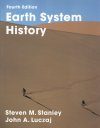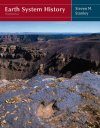Textbook
By: Steven M Stanley(Author), John A Luczaj(Author)
587 pages, colour & b/w photos, colour illustrations
![Earth System History Earth System History]()
Click to have a closer look
About this book
Contents
Customer reviews
Biography
Related titles
Recommended titles
About this book
Earth System History remains the only text for the historical geology module written from a truly integrated earth systems perspective, combining the physical and biological history of Earth. The thoroughly updated new edition includes new coverage on mass extinctions and climate change, plus improved organization based on the geologic timescale.
New to this edition:
Updated Organization
To better reflect the Geologic Time Scale, the book now covers the Neogene Age before the Quaternary Age.
Updated Coverage
Chapter 3, The Diversity of Life, now incudes modern picture of the general phylogeny and classification of life on Earth (i.e. Tree of Life)
Updated coverage of all major mass extinctions
The chapter on the Proterozoic history includes new content on iron formations and the Sudbury impact
Updated Art Program
This edition's visual program offers over 100 new graphics and photos
Premium Media Resources (available at the Book Companion Site)
Online Quizzes help students assess their current knowledge of a chapter
Interactive Timeline of Earth and Life Through Time trace important aspects of Earth or its biota through its entire history and demonstrates how these topics are interrelated, underscoring important connections.
Visual Overview Exercises provide students with a closer view of the chapter opening visual overviews, and ask related questions. Interactive Exercises, Flashcards, and Animations help students review the concepts. Chapter Objectives reiterate what students should be able to do after reading a chapter
Contents
PART I: MATERIALS, PROCESSES, AND PRINCIPLES
1. Earth as a System
2. Rock-Forming Minerals and Rocks
3. The Diversity of Life
4. Environments and Life
5. Sedimentary Environments
6. Correlation and Dating of the Rock Record
7. Evolution and the Fossil Record
8. The Theory of Plate Tectonics
9. Continental Tectonics and Mountain Chains
10. Major Chemical Cycles
PART II: THE STORY OF EARTH
11. The Hadean and Archean Eons of Precambrian Time
12. The Proterozoic Eon of Precambrian Time
13. The Early Paleozoic World
14. The Middle Paleozoic World
15. The Late Paleozoic World
16. The Early Mesozoic Era
17. The Cretaceous World
18. The Paleogene World
19. The Neogene World
20. The Holocene
Customer Reviews
Biography
Steven M. Stanley is a research professor in Paleobiology at the University of Hawaii, USA. Dr. Stanley has written three previous editions of Earth System History and a total of three editions of its predecessors, Earth and Life Through Time and Exploring Earth and Life Through Time. He has been elected to the National Academy of Sciences and the American Academy of Arts and Sciences and has received a Guggenheim Fellowship and numerous awards, including the Paleontological Society Medal, the James H. Shea Award of the National Association of Geoscience Teachers (for books authored), the Mary Clark Thompson Medal of the National Academy of Sciences, the Twenhofel Medal of the Society of the Society for Sedimentary Geology, and the Penrose Medal of the Geological Society of America.
John A. Luczaj is a field geologist and currently chair of the Geoscience unit in the Department of Natural and Applied Sciences at the University of Wisconsin-Green Bay, USA. Dr. Luczaj has conducted research on hydrothermal dolomitization, fluid-inclusions in minerals, groundwater geochemistry and aquifer recovery, geologic mapping, geomorphology, and Holocene cave deposits. One of his most important contributions was the first successful dating of diagenetic dolomite using the U-Pb method.



































